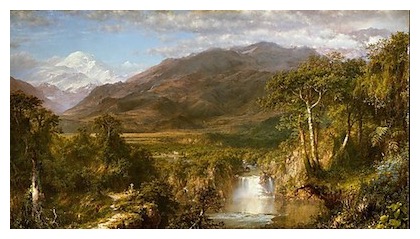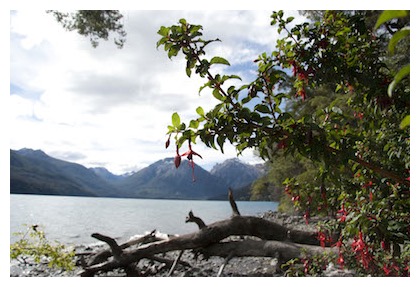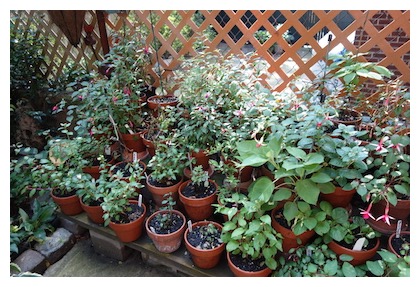
Care & Culture—A Guide to Growing Fuchsias
That beautiful basket of fuchsias from the nursery looked so lovely on the sunny deck for a few days but now... Can I get my money back, please!
That beautiful basket of fuchsias from the nursery looked so lovely on the sunny deck for a few days but now... Can I get my money back, please!
Siting & climate
Fuchsias have long been called tropical plants by general writers in general magazines. Or in many general reference works. And now, on many general gardening websites. I suppose the general writers lifted this  general description from the general reference works with little specific awareness or experience. Geographically, many fuchsia species are indeed found growing across the Equator from the Tropic of Capricorn to the Tropic of Cancer. In the Tropics, of course. Technically all plants growing in this belt are tropical.
general description from the general reference works with little specific awareness or experience. Geographically, many fuchsia species are indeed found growing across the Equator from the Tropic of Capricorn to the Tropic of Cancer. In the Tropics, of course. Technically all plants growing in this belt are tropical.
But it’s also more than a bit misleading to say fuchsias are "tropicals" and leave it at that. In gardening, and most-importantly in popular thought, "tropicals" implies that the plants arrived on your doorstep from the warmest parts of the world, especially the steamy-jungle and rain-foresty parts. Places full of coconuts and grass huts. On this side of the globe, tropicals best find shelter in the greenhouse or conservatory. Or maybe have a brief summer fling outside, to flourish among the ephemeral plantings of June, July and August before being cut short by frost and freeze.
 For fuchsias, this couldn’t be further from reality. Many species are indeed "tropical", but their hearts and roots are in the warm temperate forests of the world. Even the ultimate origin of the genus itself (➤ History of the Fuchsia). It’s important to realize this fact in understanding how fuchsias like to grow. Or if your climate is suitable for them at all. Those "tropical" fuchsias, even in the tropics, mostly grow in the cooler, mistier cloud forests found at higher elevations. Some species are quite at home and winter hardy in milder temperate zones. A number hardy to USDA Zone 7 even. Or colder sometimes with protection.
For fuchsias, this couldn’t be further from reality. Many species are indeed "tropical", but their hearts and roots are in the warm temperate forests of the world. Even the ultimate origin of the genus itself (➤ History of the Fuchsia). It’s important to realize this fact in understanding how fuchsias like to grow. Or if your climate is suitable for them at all. Those "tropical" fuchsias, even in the tropics, mostly grow in the cooler, mistier cloud forests found at higher elevations. Some species are quite at home and winter hardy in milder temperate zones. A number hardy to USDA Zone 7 even. Or colder sometimes with protection.
While not one of the species winter hardy to Zone 7, Fuchsia dependens is native to Pichincha Province in Ecuador, more or less on the Equator itself. However, F. dependens is found at elevations from 7,900 to 10,900 feet (2,400 to 3,300 meters), high above the tropical climate of the vast Amazon region to the east. There are many other "tropical" fuchsia species fanning into the regions north and south of the Equator but it's rare to find many of these so-called "tropicals" naturally ranging much lower than about 4,000 to 4,500 feet (1,200 to 1,400 meters). Most range significantly higher in elevation. In some favorable areas, a little lower. They don't grow into many of the lower areas of the Tropics because it's generally much too hot and humid down there for their liking.
 At increasingly higher latitudes, past the tropical belt, fuchsias are again found at lower elevations. But usually not too low unless near the cooling effects of the sea. By the time, we reach Fuchsia magellanica in Patagonia, though, the climate can be positively frigid and that species has additionally evolved to survive raw winds and considerable cold and frost. It can be found down to sea level in the Tierra del Fuego.
At increasingly higher latitudes, past the tropical belt, fuchsias are again found at lower elevations. But usually not too low unless near the cooling effects of the sea. By the time, we reach Fuchsia magellanica in Patagonia, though, the climate can be positively frigid and that species has additionally evolved to survive raw winds and considerable cold and frost. It can be found down to sea level in the Tierra del Fuego.
On the other hand, Fuchsia triphylla occurs in the highlands of Hispaniola (Haiti and the Dominican Republic) from about 3,600 to 6,500 feet (1,100 to 2,000 meters). It's evolved to prefer warmer temperatures, even lots warmer, and it generally shivers to death with the mere hint of frost. [1] But it won’t long survive the one thing most other fuchsias won’t either: truly tropical heat and humidity. Where there's more heat and humidity, fuchsias almost always pack up their belongings and move into higher elevations where the air's much fresher and the temperatures are much lower in compensation.
 What, then, do fuchsia hybrids like in our gardens? Generally the same things as their wild cousins. They're usually forest plants so a spot with bright, filtered shade, such as you’ll find under a high tree canopy, is ideal. Morning sun is good, but the plants should have some protection from the harshest rays of the afternoon. In cooler northern, far southern or maritime climes fuchsias can take more direct sun. Even bask in it all day long in the right areas in England or the Pacific Northwest, for example. In warmer ones, they like to take less. Just remember that the more sun they get, the more attention to watering they’ll need.
What, then, do fuchsia hybrids like in our gardens? Generally the same things as their wild cousins. They're usually forest plants so a spot with bright, filtered shade, such as you’ll find under a high tree canopy, is ideal. Morning sun is good, but the plants should have some protection from the harshest rays of the afternoon. In cooler northern, far southern or maritime climes fuchsias can take more direct sun. Even bask in it all day long in the right areas in England or the Pacific Northwest, for example. In warmer ones, they like to take less. Just remember that the more sun they get, the more attention to watering they’ll need.
Constant high humidity poses a real problem for fuchsias if the temperatures are also too hot. Especially heat and humidity together at night. That's a dreadful combination for most fuchsias. Plants will sulk, decline and eventually die away if these conditions go on too long. This is why fuchsias rarely survive summers in the southern United States unless they’re carefully grown in the cooler mountains. Additionally, there should always be good circulation around the plants to help move the humidity in the air and keep them comfortable. In too close an environment, pests and diseases can also become a problem.
 In hotter, drier climates, such as Australia or Southern California, many fuchsias will still do well but frequent misting will be essential to keeping them happy. And the heat down. They do need some humidity. Many species are native to cool cloud forests, after all. It's just constantly hot and humid conditions that they don't tolerate so well. With the right treatment, though, fuchsias can often easily flourish in these hotter, drier areas even if they seem a bit far from their heritage there. Adequate shading, along with the misting, is also crucial. If you’re gardening too far away from the immediate gentling effects of the ocean or the mitigating effects of altitude in places like Southern California or Australia, however, fuchsias will almost certainly quite literally dry to a crisp at some times of the year. In areas too far inland and too hot, short of an air-conditioned greenhouse, there's really no amount of shade or mist that will get fuchsias through the summer. If you're not sure if your climate in right, try a few.
In hotter, drier climates, such as Australia or Southern California, many fuchsias will still do well but frequent misting will be essential to keeping them happy. And the heat down. They do need some humidity. Many species are native to cool cloud forests, after all. It's just constantly hot and humid conditions that they don't tolerate so well. With the right treatment, though, fuchsias can often easily flourish in these hotter, drier areas even if they seem a bit far from their heritage there. Adequate shading, along with the misting, is also crucial. If you’re gardening too far away from the immediate gentling effects of the ocean or the mitigating effects of altitude in places like Southern California or Australia, however, fuchsias will almost certainly quite literally dry to a crisp at some times of the year. In areas too far inland and too hot, short of an air-conditioned greenhouse, there's really no amount of shade or mist that will get fuchsias through the summer. If you're not sure if your climate in right, try a few.
In a city garden, or on a terrace or balcony, you might experience similar conditions at times. In the summer of 2011, there was a bad heat wave in New York City that lasted for a few days. The national weather station at Belvedere Castle, in the middle of Central Park, apparently hit 104˚ F (or just about 40˚ C). Even in the shelter of my garden, I got quite a workout on my thermometer. It recorded the highest temperature I can remember at 103˚ F. It was an unusual heat, but misting my plants frequently during the assault actually helped bring that temperature down into the mid 80’s (30˚ C). Except for the odd loss, It saved the day and my fuchsias survived the crisis rather well for the wear.
[1] That said, it might be marginally hardier than assumed. The highest elevations on Hispaniola do experience frost and specimen sheets in herbaria don't tell the whole story. Botanical descriptions don't necessarily cover their subjects in four dimensions. A couple of winters ago, either. 'Gartenmeister Bonstedt,' one of the hybrid progeny of Fuchsia triphylla x fulgens, survived a mild winter in my USDA Zone 7b-8 garden by sprouting again from the roots in the spring. Not expected behavior for either species but knows how many primeval characteristics of the genus are locked away until perhaps expressed in the crosses. ➤ Return to Reading.

But it’s also more than a bit misleading to say fuchsias are "tropicals" and leave it at that. In gardening, and most-importantly in popular thought, "tropicals" implies that the plants arrived on your doorstep from the warmest parts of the world, especially the steamy-jungle and rain-foresty parts. Places full of coconuts and grass huts. On this side of the globe, tropicals best find shelter in the greenhouse or conservatory. Or maybe have a brief summer fling outside, to flourish among the ephemeral plantings of June, July and August before being cut short by frost and freeze.

While not one of the species winter hardy to Zone 7, Fuchsia dependens is native to Pichincha Province in Ecuador, more or less on the Equator itself. However, F. dependens is found at elevations from 7,900 to 10,900 feet (2,400 to 3,300 meters), high above the tropical climate of the vast Amazon region to the east. There are many other "tropical" fuchsia species fanning into the regions north and south of the Equator but it's rare to find many of these so-called "tropicals" naturally ranging much lower than about 4,000 to 4,500 feet (1,200 to 1,400 meters). Most range significantly higher in elevation. In some favorable areas, a little lower. They don't grow into many of the lower areas of the Tropics because it's generally much too hot and humid down there for their liking.

On the other hand, Fuchsia triphylla occurs in the highlands of Hispaniola (Haiti and the Dominican Republic) from about 3,600 to 6,500 feet (1,100 to 2,000 meters). It's evolved to prefer warmer temperatures, even lots warmer, and it generally shivers to death with the mere hint of frost. [1] But it won’t long survive the one thing most other fuchsias won’t either: truly tropical heat and humidity. Where there's more heat and humidity, fuchsias almost always pack up their belongings and move into higher elevations where the air's much fresher and the temperatures are much lower in compensation.

Constant high humidity poses a real problem for fuchsias if the temperatures are also too hot. Especially heat and humidity together at night. That's a dreadful combination for most fuchsias. Plants will sulk, decline and eventually die away if these conditions go on too long. This is why fuchsias rarely survive summers in the southern United States unless they’re carefully grown in the cooler mountains. Additionally, there should always be good circulation around the plants to help move the humidity in the air and keep them comfortable. In too close an environment, pests and diseases can also become a problem.

In a city garden, or on a terrace or balcony, you might experience similar conditions at times. In the summer of 2011, there was a bad heat wave in New York City that lasted for a few days. The national weather station at Belvedere Castle, in the middle of Central Park, apparently hit 104˚ F (or just about 40˚ C). Even in the shelter of my garden, I got quite a workout on my thermometer. It recorded the highest temperature I can remember at 103˚ F. It was an unusual heat, but misting my plants frequently during the assault actually helped bring that temperature down into the mid 80’s (30˚ C). Except for the odd loss, It saved the day and my fuchsias survived the crisis rather well for the wear.
[1] That said, it might be marginally hardier than assumed. The highest elevations on Hispaniola do experience frost and specimen sheets in herbaria don't tell the whole story. Botanical descriptions don't necessarily cover their subjects in four dimensions. A couple of winters ago, either. 'Gartenmeister Bonstedt,' one of the hybrid progeny of Fuchsia triphylla x fulgens, survived a mild winter in my USDA Zone 7b-8 garden by sprouting again from the roots in the spring. Not expected behavior for either species but knows how many primeval characteristics of the genus are locked away until perhaps expressed in the crosses. ➤ Return to Reading.
Chapter I
Siting & Climate
Siting & Climate
Chapter III
Propagating & Potting Up
Propagating & Potting Up
Chapter IV
Growing On
Growing On
Chapter VI
Pinching & Shaping
Pinching & Shaping
Chapter VII
Special Shapes
Special Shapes